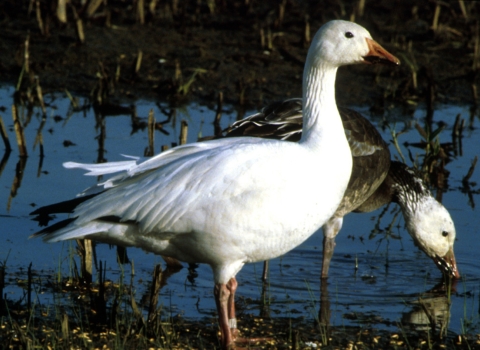Bicycle and Pedestrian Daily Fee Removed
The U.S. Fish & Wildlife Service has implemented the removal of the $2 daily pedestrian and cyclist fee following a 14-day public comment period. A total of 143 public comments were received during the comment period from September 18, 2024 to October 2, 2024. Of these comments 83 supported the proposed fee change, 54 were against the proposed fee change, and 6 were related to other topics or did not provide an opinion.
Answers to frequently asked questions and concerns can be found below.
Frequently Asked Questions
What are the benefits of removing the bicycle/pedestrian fee?
- Removing the fee will help reduce gatehouse congestion, increase overall safety, and reduce vehicle emissions. Gatehouse fee collectors and the public consistently note that processing pedestrians and cyclists creates bottlenecks at the entrance, as well as safety concerns as vulnerable road users must queue in between vehicles. Reduced congestion will additionally result in fewer emissions, and incentivize eco-friendly travel to and around the refuge.
Will the loss of revenue negatively impact visitor services and refuge facilities?
- Bicycle/pedestrian fee revenue accounts for approximately 1% of the annual average. As a result, the refuge anticipates no significant impacts to user experience. Additionally, many concerns shared during the comment period, such as upkeep of bathrooms or buildings, are not typically funded through the recreation fee program. Incentivizing local visitors to bike or walk may also free up additional parking spaces for users who choose to drive and may otherwise be turned away during vehicle capacity closures. The $5 daily rate collected from vehicle users in this scenario would offset the loss from the $2 pedestrian / cyclist daily rate.
Will incentivizing biking and walking to the refuge increase conflicts between motorists and other users on the refuge road?
- Multimodal safety on the roadway is an ongoing priority for the refuge, including short-term structural solutions such as speedbumps, flex posts, and in-street crosswalk signs, as well as long-term social and behavioral change and facilitating programs that increase road user awareness. Refuge law enforcement also addresses speeding and unsafe road behavior on site. The refuge believes these approaches are more effective at improving multimodal safety than measures to limit pedestrian and cyclist access. We will continue to monitor road conditions and safety and adjust strategies as necessary if this fee change results in a significant increase of mixed-mobility use on the road.
Will the change increase parking pressure elsewhere on Plum Island?
- The refuge anticipates no major changes to parking pressure on the island by incentivizing parking or walking in to the refuge. Neighborhood streets require a resident parking permit or prohibit parking entirely, and nearby town beach lots are either resident permit only or up to $20 per day. Violators are regularly ticketed or towed by police officers and parking enforcement, whose presence is increased on the island during the busy summer season. The refuge will continue to work with local parking and law enforcement to evaluate and respond to any impacts from the fee change.
Are bikers and walkers receiving an unfair benefit?
- Most walkers and bikers entering the refuge are local visitors who also drive in during the year. As a result, they purchase an annual or lifetime pass. A minority of walkers and bikers are one-time visitors currently assessed the day rate. Therefore, most walkers and bikers on the refuge at any given time are not paying less than other users, as they are in possession of an annual or lifetime pass. Removal of the fee will not reduce their financial contribution, but simply allow them to bypass the gatehouse line when entering.
What about individuals who are unable to walk or bike onto the refuge?
- Several avenues exist to enhance access to refuges and other federally managed public lands. Individuals with qualifying physical or developmental constraints are eligible to receive a free lifetime American the Beautiful Pass. Seniors (62+) are eligible to receive a reduced annual or lifetime America the Beautiful pass which affords entry to all federal public lands. Active duty military members, veterans, and Gold Star families are all also eligible for free annual and/or lifetime America the Beautiful passes. The refuge also works with special programs, including the 'Every Kid Outdoors' initiative that provides free America the Beautiful passes to 4th grade students who complete a qualifying outdoor experience. Finally, the refuge provides a limited number of free day passes at special events that reach families who may face financial and logistical constraints to entry.



